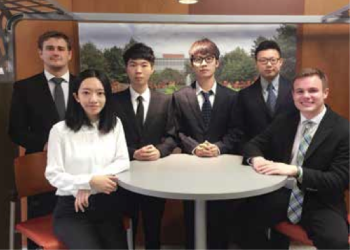Applied Engineering
Projects
We gratefully acknowledge Jim Manely and the Demmer Center for Business Transformation at Michigan State University for their guidance and assistance with our projects. We gratefully acknowledge Judy S. Jacobs, Director, Corporate & Student Relations Office, Michigan State University, Department of Supply Chain Management for her assistance in securing projects.
For information on becoming a project sponsor, please contact Dr. Laura Genik.
Applied Engineering students participate in Spring Term Design Day. The following were the project sponsors and projects for the Spring of 2017:
Kohler Company: Space Planning
 Kohler Co. is a private company started in 1873 with more than 50 manufacturing locations on 6 continents and more than 30,000 associates worldwide. The Kohler family of businesses creates products that set the standard in kitchen and bath, engines and generators, furniture and tile, as well as resort, recreation and real estate.
Kohler Co. is a private company started in 1873 with more than 50 manufacturing locations on 6 continents and more than 30,000 associates worldwide. The Kohler family of businesses creates products that set the standard in kitchen and bath, engines and generators, furniture and tile, as well as resort, recreation and real estate.
Through a long-term development period, Kohler has faced many challenges and opportunities. As Kohler continues to grow, they will need a new floor plan for their offices; a plan that will attract and retain talent, as well provide the best atmosphere for collaboration and business growth.
Kohler Co. Space Planning Project (KCSP) is initiated to focus on creating a new floor plan for 400 employees in Wisconsin. The project is based on the idea of constructing a building next to the Kohler Distribution Center. This will form a comfortable and efficient office environment with more space, windows, amenities, technology and collaboration areas. The other major purpose of this floor plan is to decrease expenses by becoming more sustainable and efficient.
Both the building process and the maintenance process will be sustainable to face the growth target in next 10-20 years. The inner design of the project will improve employee work experience and associates’ executive initiatives. The new floor plan’s office setting will create a more effective and efficient flow of communication. Nonetheless, the new floor plan will have divided sections for each department, but will also be designed to improve interdepartmental collaboration.
Kohler Company: Hospitality and Inventory Rationalization
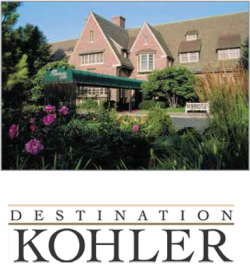 Destination Kohler is a hospitality and real estate subsidiary of the well-known Kohler Company headquartered in Kohler, Wisconsin. It encompasses many elite resorts and golf courses such as the Old Course Hotel in Saint Andrews, Scotland and the Whistling Straits golf course in Sheboygan, Wisconsin.
Destination Kohler is a hospitality and real estate subsidiary of the well-known Kohler Company headquartered in Kohler, Wisconsin. It encompasses many elite resorts and golf courses such as the Old Course Hotel in Saint Andrews, Scotland and the Whistling Straits golf course in Sheboygan, Wisconsin.
Currently Kohler owns a warehouse located in Sheboygan Falls, Wisconsin that stores all of their attic stock from resort renovations across their 9 properties, as well as some materials for their new facility scheduled to open in July. This inventory is currently sorted by property, and racks have been installed to house all materials. However, to this point none of these materials have been documented nor has any formal inventory system been implemented.
The objective of this project is to identify proper processes, inventory levels and systems in place to manage inventory and ensure the company can continuously provide a higher level of gracious living for their Hospitality and Real Estate divisions. The solution to the current state of inventory will benefit Kohler to reduce the global environmental footprint through rationalization of current inventory. Analyzing competitors’ current inventory management allows Kohler to understand the competitive advantages. Further, it is necessary to identify inventory management software to better keep track of changes in inventory. Finally, developing an action implementation plan helps bring the analysis to reality.

Team Members (L-R): Jeff Osment, Bingyan Lin, Andrew McClennen, Jocelyn Modelski, Frank Sardelli, Maggie Yue, Zach Fecher
Kohler Company: Total Cost of Ownership Analysis
For well over a century, Kohler has made the concept of gracious living their mission. With more than 50,000 locations on six continents and a team of over 30,000 associates, they have touched every corner of the world with this goal. Since the company’s start in 1873, they have expanded from kitchen and bath, to furniture and decorative products, engines and generators, and golf resort destinations. Due to Kohler’s global reach, the use of supply chain management is more important than ever. Thus, they have sought the help of o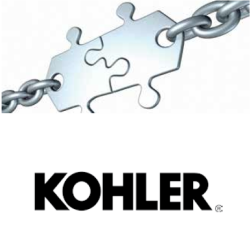 ur team to assess their SCM system.
ur team to assess their SCM system.
The first task of this project was to establish a Total Cost of Ownership analysis for Kohler’s Global Faucets division. The Total Cost of Ownership is a quantifiable estimation tool that incorporates the total indirect and direct costs associated with a product and its placement. This includes, but is not limited to procurement rates, operational costs, logistic costs, administrative costs, inventory costs, and other additional costs, to help Kohler determine the most efficient supply chain for a given product/part.
The second aspect of this project was to benchmark Kohler against other product-based companies using similar TCO metrics. As instructed by the Kohler team sponsors, we designed a user-friendly web based interface, which can analyze and display coherent and useful supply chain metrics based on the information and formulas previously established. For example, the interface would allow a user to input information on a certain item or product and then provide all the costs associated with the item within every process involved.
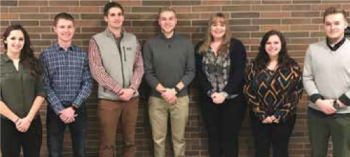
Team Members (L-R): Angelina Bradley, Alec Wilhoite, Alex Knuth, Jordan Lehman, Leyla Solaksubasi, Kayla Ferrell, Riley Botwinski
Michigan National Guard: Comparative Analysis of Resiliency Programs
This past year the Michigan National Guard received a 1st place Environmental Security Award for Sustainability from the National Guard Bureau. They have published more than 15 environment related feature stories since 2009 and are a leader amongst national guards when it comes to resiliency and sustainability.
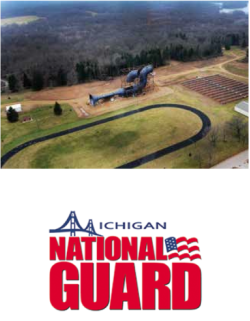 Michigan State University has pursued sustainable projects and research all over the world in an effort to increase awareness and sustainable prosperity. “Be Spartan Green” is not only a slogan for the campus but a way of life for many of MSU’s researchers and innovative minds.
Michigan State University has pursued sustainable projects and research all over the world in an effort to increase awareness and sustainable prosperity. “Be Spartan Green” is not only a slogan for the campus but a way of life for many of MSU’s researchers and innovative minds.
The Michigan National Guard has decided to partner with the College of Engineering at Michigan State University to draft a white paper for the National Guard to take to leadership. This white paper will investigate, compare and analyze different power programs that have worked or not worked and will present the best path to energy resiliency for the National Guard. The Michigan National Guard will use the analyzation of successful energy resilience programs to request additional funding for sites around Michigan. These chosen energy programs will allow certain National Guard bases to operate “off the grid” while also being sustainable and environmentally aware.
The Applied Engineering Sciences students assigned to this project look to not only improve the current projects underway at the Michigan National Guard sites but also look to more innovative energy projects in the solar, wind and other sustainable energy types. Once the best sustainable option is chosen and brought forth to the Michigan National Guard, the team hopes that this information will not only improve Michigan’s National Guard sites, but also National Guard sites around the country.
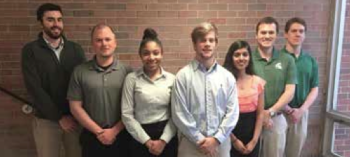
Team Members (L-R): Steven Michos, Jason Humphreys, Joi Taylor, Robert Hughes, Meghana Gudivada, Nick Flory, Eric Holst
Ranir LLC: Continuous Improvement/Lean Manufacturing Project for a Toothbrush Packaging Line
Ranir is a leading global private manufacturer of oral and personal healthcare headquartered in Grand Rapids, Michigan. The company is driven by the belief that oral preventive care is essential to maintaining overall superior health. Recently the company has been able to expand their global footprint by innovating into new product lines and entering new global markets through acquisitions.
 This project will be designed to improve the throughput and efficiency of products on this work center. Workstations that will be observed will have multiple changeovers, (such as different product being run through the line), the time impacted by those changeovers per shift, and product complexity by toothbrush style, toothbrushes per package, and tooling for the process.
This project will be designed to improve the throughput and efficiency of products on this work center. Workstations that will be observed will have multiple changeovers, (such as different product being run through the line), the time impacted by those changeovers per shift, and product complexity by toothbrush style, toothbrushes per package, and tooling for the process.
Students will use an A3 form to help identify current state and future state goals. The team will be led by a Manufacturing Engineer in the toothbrush business unit. Data will be collected in the form of pictures, videos, and timing of procedures to help achieve the desired goals. Procedures and documents may need to be created to help with the training of future workers.
Students should be able to present to Ranir and to MSU leadership, the current state situation, inclusive of the impact to current production efficiencies. Data will need to be provided that supports current state situations, which will highlight the loss of production hours due to multiple changeovers. Data will also need to be provided to support the future state improvements, based upon what they come up with to help minimize the time required for changeovers.
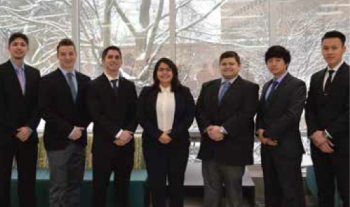
Team Members (L-R): Armando Quiroga, Sean O’Malley, Joseph Haack, Beatriz Ibarra, Matthew Lucero, Khai Van, Phuoc Ngo
Union Pacific Railroad: Wood Tie Disposal Optimization Project
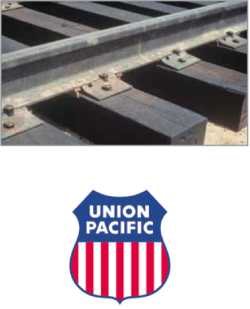 Union Pacific (UP) is one of the world’s largest transportation companies with 8,500 locomotives and 44,500 employees nationwide. It is the largest and one of the oldest freight hauling railroad companies in the United States. The original Union Pacific was incorporated on July 1, 1862 under President Abraham Lincoln. Headquartered in Omaha, Nebraska, the company predominately serves states west of the Mississippi River. UP is constantly updating its infrastructure and, with a span of over 32,000 route-miles, has a massive demand for disposal of railroad material. One of the major extra expenditures that Union Pacific faces is handling used rail ties.
Union Pacific (UP) is one of the world’s largest transportation companies with 8,500 locomotives and 44,500 employees nationwide. It is the largest and one of the oldest freight hauling railroad companies in the United States. The original Union Pacific was incorporated on July 1, 1862 under President Abraham Lincoln. Headquartered in Omaha, Nebraska, the company predominately serves states west of the Mississippi River. UP is constantly updating its infrastructure and, with a span of over 32,000 route-miles, has a massive demand for disposal of railroad material. One of the major extra expenditures that Union Pacific faces is handling used rail ties.
Typically made of treated wood, rail ties are the beams laid perpendicular to railroad tracks. Their purpose is to distribute weight, hold rails upright and keep them correctly spaced apart. Currently, Union Pacific removes over 4.6 million ties per year through a process that is 95% automated. After removal, ties are laid beside the tracks to await pickup from a private contractor. These contractors are hired by the company to transport and properly reallocate and/or dispose of the material. UP questions whether its disposal practices, and the practices of its contractors, are the most efficient solution in terms of cost and use of resources. Currently, it spends 10s of millions of dollars on disposal of used wood ties. Union Pacific is seeking a better, more efficient way to potentially reuse, recycle or dispose of these ties that will lower costs, increase capacity on the railroad and improve environmental sustainability.

Team Members (L-R): Khoa Nguyen, Daniel Roe, Kennen Olsen, Alyssa Hoffman, William McFarland, Joseph Slater, Emily Matz
Ingersoll Rand: Global 3PL Landscape
 Ingersoll-Rand is a global diversified industrial company formed in 1905. The company’s corporate headquarters are in Dublin, Ireland, and its American headquarters are in Davidson, North Carolina. Ingersoll-Rand (IR) has been a constituent of the S&P 500 Index since 2010. IR has 51 plants worldwide and is comprised of six major subsidiaries, Club Car, Ingersoll Rand, Thermo King, Trane, Aro, and American Standard Heating & Air, all dedicated towards advancing quality of life by creating comfortable, sustainable and efficient environments. IR aims to enhance the quality and comfort of air in homes and buildings, improve the transportation and protection of food and perishables, and increase industrial productivity and efficiency.
Ingersoll-Rand is a global diversified industrial company formed in 1905. The company’s corporate headquarters are in Dublin, Ireland, and its American headquarters are in Davidson, North Carolina. Ingersoll-Rand (IR) has been a constituent of the S&P 500 Index since 2010. IR has 51 plants worldwide and is comprised of six major subsidiaries, Club Car, Ingersoll Rand, Thermo King, Trane, Aro, and American Standard Heating & Air, all dedicated towards advancing quality of life by creating comfortable, sustainable and efficient environments. IR aims to enhance the quality and comfort of air in homes and buildings, improve the transportation and protection of food and perishables, and increase industrial productivity and efficiency.
With data from inbound and outbound warehouses, this project is aimed towards understanding Ingersoll Rand’s global 3PL landscape. Using the locations of warehouses and the evaluation of their footprint (size, location, scope, owner name, provider), IR will be able to locate specific SBUs by priority and use better decision- making across the various markets that IR occupies. With this in mind, IR will be able to improve customer satisfaction and reduce operating costs by creating a comprehensive map of their global 3PL landscape. The goal of this map will be to help consolidate the smaller 3PL strategy into a more comprehensive, company-wide 3PL approach.
Ingersoll Rand: Logistics Inflation/Deflation Modeling
Ingersoll Rand is a global industrial company consisting of two distinct divisions. The industrial division focuses on products related to air compression and power tools. The second division is climate; it includes air conditioning, refrigeration, Thermo King, and Trane cooling solutions.
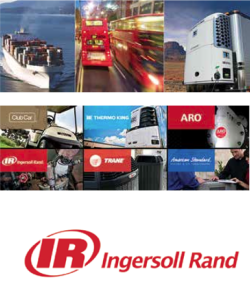 Through a logistics perspective, Ingersoll Rand strives to provide low- cost and high-quality services when moving products between factories, distribution centers and warehouses. Currently, Ingersoll Rand outsources their transportation methods through a 3PL company. Ingersoll Rand’s current logistics inflation/deflation model is very generic and routinely deviates from the actual costs. Our goal is to produce a more accurate inflation/deflation model based on historic performance and future estimates to statistically derive the proper price for all cost components. The appropriate methods for retrieving marketplace insight will be discovered and will allow us to build a model that can accurately predict the cost of each transportation mode.
Through a logistics perspective, Ingersoll Rand strives to provide low- cost and high-quality services when moving products between factories, distribution centers and warehouses. Currently, Ingersoll Rand outsources their transportation methods through a 3PL company. Ingersoll Rand’s current logistics inflation/deflation model is very generic and routinely deviates from the actual costs. Our goal is to produce a more accurate inflation/deflation model based on historic performance and future estimates to statistically derive the proper price for all cost components. The appropriate methods for retrieving marketplace insight will be discovered and will allow us to build a model that can accurately predict the cost of each transportation mode.
To develop this model, the annual reports over the past decade will be examined to identify areas that have traditionally provided inaccurate predictions. Once these problem areas are identified, the problematic data will be examined and cross-referenced with each year to help explain why the past modeling failed. Finally, the data will be compiled to help improve the analytical and predictive abilities of the modeling software. Also, it will be imperative to observe the external variables associated with logistical costs. These variables can range from specific transportation locations to specific transportation modes such as TL, LTL, Ocean, Air and railroad. Such factors will have effects on market fuel costs and other rates charged by 3PL companies.
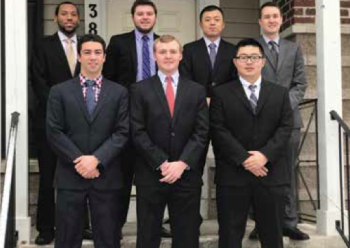
Team Members (L-R): Dell Davenport, Jack Tolbert, Clay King, Elliot Zimmerman, Pu Gao, Bill Fang, Sam Barnard
Ingersoll Rand: Trane: Transportation Mode Optimization
Ingersoll Rand, which started in 1871, provides market-leading solutions and services to its customers. As of May 2016, Ingersoll Rand employed 45,000 people and realized $13.3 billion in revenue. The Trane business unit is divided into two segments: Climate and Industrial. This project will focus on the climate segment of the business.
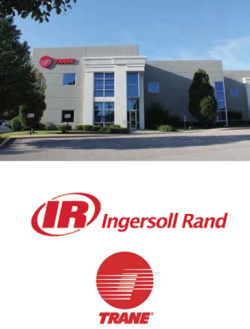 Trane Inc. is a subsidiary of Ingersoll Rand Inc., with locations at three plants throughout the United States: Tyler, Texas; Trenton, New Jersey and Vidalia, Georgia. Trane offers a wide range of energy efficient residential and commercial systems, including heating, ventilation, and air-conditioning. These finished goods and aftermarket parts are shipped multiple times from one of the three factories to their largest distribution center located in Bridgeton, Missouri.
Trane Inc. is a subsidiary of Ingersoll Rand Inc., with locations at three plants throughout the United States: Tyler, Texas; Trenton, New Jersey and Vidalia, Georgia. Trane offers a wide range of energy efficient residential and commercial systems, including heating, ventilation, and air-conditioning. These finished goods and aftermarket parts are shipped multiple times from one of the three factories to their largest distribution center located in Bridgeton, Missouri.
There exists no tool today within the company to study and optimize these transportation modes for the finished goods, and as a result, cycle time is extended to deliver products to customers at higher transportation costs. An additional point to consider is that extended transportation cycle time results in holding higher inventory in the supply chain, also a cost driver, in terms of increased working capital above healthy levels.
The output of the project will be a recommendation to the Global Logistics and Distribution Team of Ingersoll Rand to change its transportation modes in a way that optimizes the on-time delivery and profitability. In addition, the team will analyze the footprint opportunity reductions of these improved routes and compare them to the routes that the company currently uses.
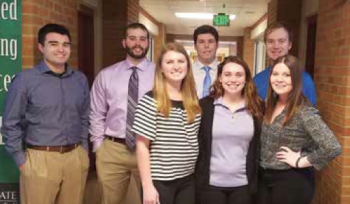
Team Members (L-R): Carl McConkie, Chris Talaga, Jen Maisner, Jordan Hughes, Justice Schihl, Austin Gross, Shawnee Joyce
Ingersoll Rand: Global Risk to Transportation Modes
Headquartered in Davidson, North Carolina and founded in 1871, Ingersoll Rand is a diversified industrial manufacturing company which advances the quality of life by creating comfortable, sustainable and efficient environments. They serve customers in global commercial, industrial and residential markets with market-leading brands such as Thermo King and Trane. For over 100 years, they have been operating as a distinguished example of integrity and product quality.
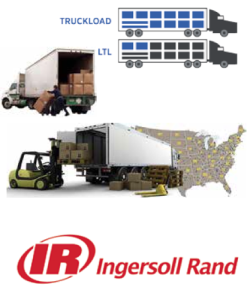 In September 2016, a major South Korean ocean carrier, Hanjin, went bankrupt. When they declared bankruptcy, they had nearly a hundred vessels full of containers on the seas around the world, which left the cargo on the ships stranded out on the water. Many companies were negatively affected by this surprise event. Hanjin’s bankruptcy served as an alert to Ingersoll Rand that risks to transportation are never far away and oftentimes hard to predict; it also provided them with an incentive to assess their risk exposure in other transportation modes, namely truckload (TL) and less-than-truckload (LTL), in order to be better prepared for unexpected events.
In September 2016, a major South Korean ocean carrier, Hanjin, went bankrupt. When they declared bankruptcy, they had nearly a hundred vessels full of containers on the seas around the world, which left the cargo on the ships stranded out on the water. Many companies were negatively affected by this surprise event. Hanjin’s bankruptcy served as an alert to Ingersoll Rand that risks to transportation are never far away and oftentimes hard to predict; it also provided them with an incentive to assess their risk exposure in other transportation modes, namely truckload (TL) and less-than-truckload (LTL), in order to be better prepared for unexpected events.
The primary purpose of this project is to assist Ingersoll Rand in assessing and analyzing risks associated with TL and LTL transportation modes in the U.S., which comprise nearly 70% of their shipping interests in the country. There are plenty of factors that influence the trucking industry, like fuel prices, labor costs, and government regulations. This project will provide Ingersoll Rand with a comprehensive and concise risk awareness of the U.S. TL and LTL transportation modes. It will include a detailed report on events that happened in 2016 which affected the U.S. TL and LTL industry as well as potential influencing factors on the horizon for the year of 2017. In addition, a document with all of the recommendations that were generated during the research and analyses will be included. This information will provide Ingersoll Rand with a better view of the tumultuous U.S. trucking industry, allowing them to respond more effectively and to successfully mitigate risks that are associated with their domestic shipping lines.
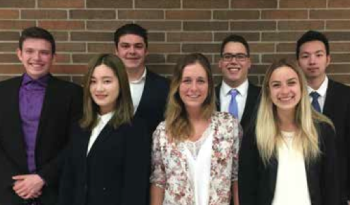
Team Members (L-R): Zack Terry, Shiqi Huang, Thomas Quinn, Courtnee Sellers, Pedro Alviarez, Elaine Johnston, Dong Ding
Intel Corporation: Automated Repairable Inventory Management & Tracking
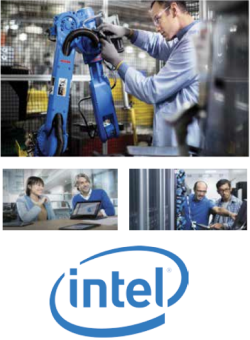 Intel Corporation is a multinational technology company headquartered in Santa Clara, CA. It is the world’s largest, and most valued semiconductor chip maker. The manufacturing of advanced processors requires expensive equipment, which regularly requires maintenance. This project focuses on the repair process for the equipment used in Intel’s manufacturing factories. The current repair process requires the involvement of several third-party companies, making it difficult to maintain visibility throughout the process.
Intel Corporation is a multinational technology company headquartered in Santa Clara, CA. It is the world’s largest, and most valued semiconductor chip maker. The manufacturing of advanced processors requires expensive equipment, which regularly requires maintenance. This project focuses on the repair process for the equipment used in Intel’s manufacturing factories. The current repair process requires the involvement of several third-party companies, making it difficult to maintain visibility throughout the process.
The project’s goal is to decrease the time it takes for Intel’s internal inventory to be repaired. To accomplish this, the visibility throughout the system will be improved by increasing automation as much as possible. This involves researching the current steps in the repair loop, performing a SWOT analysis on the possible improvements developed for each step, and analyzing the third-party companies for possible improvements. This project will require bringing in more technology to the Intel repair supply chain and improving the tracking of the inventory.
Successful implementation of this project would give a much clearer and more accurate picture of repair loop inventory leading to substantially increased throughput time and lower overall inventory requirements. This would dramatically decrease part and warehousing spends while allowing for greater availability through network optimization and live identification and management of supply chain bottlenecks.
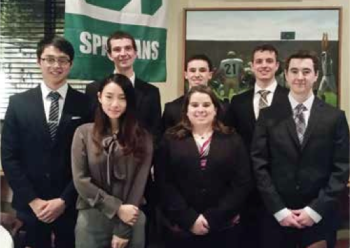
Team Members (L-R): Junlin (Shawn) Xiang, Hanyi (Hannah) Zhou, Paul Salach, Aaron Parmet, Katie Ryan, Kyle Thomas, Justin Russell
Johnson Controls/MSU IPF: Design of Decentralized, Decarbonized District Energy Strategy
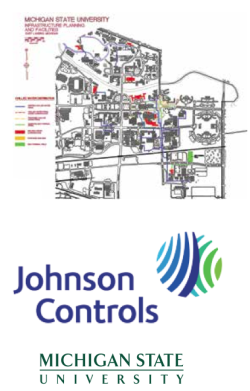 Michigan State University is constantly on the lookout for new ways to improve its campus’ sustainability, and has a multitude of goals that it wishes to reach over the coming years. As part of its effort to reach these goals, the University’s Infrastructure Planning and Facilities division has instructed this team to analyze energy use data on campus and determine an effective Decentralized, Decarbonized District Energy Strategy (D3E) to improve campus energy usage.
Michigan State University is constantly on the lookout for new ways to improve its campus’ sustainability, and has a multitude of goals that it wishes to reach over the coming years. As part of its effort to reach these goals, the University’s Infrastructure Planning and Facilities division has instructed this team to analyze energy use data on campus and determine an effective Decentralized, Decarbonized District Energy Strategy (D3E) to improve campus energy usage.
The central area of MSU’s campus, shown to the right of this summary encircled in red, was designated by IPF as a target for D3E implementation. Energy data, including heating, cooling and electricity use, was then provided for analysis. Once data had been reviewed and organized, energy use could be modeled by using inverse models. Once this was completed, the team could propose potential improvements that would be modeled in conjunction with sponsor Johnson Controls using LEAN energy analysis software.
Several determinations were made once LEAN energy modeling was complete, and the team’s D3E proposal, along with additional potential improvements, were defined. The team then began using central plant optimization, a service also provided by sponsor Johnson Controls, to size the plan effectively to the target area.
With a strategy effectively modeled, and showing potential energy use improvements, it could then tackle quantifying costs and tradeoffs to implementing the plan, including those associated with implementing only parts of the D3E proposal. With this complete, MSU IPF can then use the project in the future as a potential model for improvements in energy use in the defined central region of campus.

Team Members (L-R): Daniel Feenstra, Jasmine Lin, Derek Stockman, Junyu Liu, Edward Okuniewski, Hanish Mehtra, Change Joon Kim, Rachel Gasparovich
Johnson Controls/MSU IPF: Design of Decentralized, Decarbonized District Energy Strategy
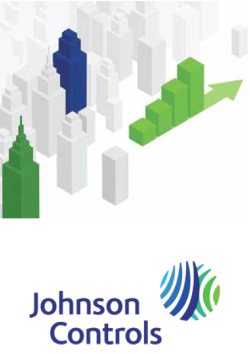 Throughout the semester, the team will work with Johnson Controls (JCI) in cooperation with Michigan State Infrastructure Planning and Facilities (MSU IPF). Johnson Controls is an industry leader in building efficiency and has earned its spot in the Fortune 500 for its integrative facility management. JCI has integrated a variety of buildings in more than 500 locations worldwide, ranging from industrial to healthcare buildings. Infrastructure Planning and Facilities (IPF) maintains the integrity of MSU’s buildings, they pride themselves on the key values of stewardship, innovation, and service excellence.
Throughout the semester, the team will work with Johnson Controls (JCI) in cooperation with Michigan State Infrastructure Planning and Facilities (MSU IPF). Johnson Controls is an industry leader in building efficiency and has earned its spot in the Fortune 500 for its integrative facility management. JCI has integrated a variety of buildings in more than 500 locations worldwide, ranging from industrial to healthcare buildings. Infrastructure Planning and Facilities (IPF) maintains the integrity of MSU’s buildings, they pride themselves on the key values of stewardship, innovation, and service excellence.
The overall goal of the project is to complete a conceptual design of a decentralized, decarbonized district energy strategy for a collection of buildings on Michigan State’s campus. There are two distinct steps within the project, which are achieved through Johnson Controls’ tools: LEAN Analysis and Optimization Solutions.
First, the collection of annual heating, cooling and energy costs will be used with local weather data in the LEAN Analysis tool. This tool will produce information, which will allow the team to further analyze areas of improvement for the buildings. Next, Optimization Solutions will provide further information on the possible solutions.
With the information from the LEAN Analysis and Optimization Solutions, the team will evaluate potential environmental, economic and educational impacts of the proposed design. The proposed design will evaluate trade-offs in relation to costs and operations with the ultimate goal of reducing costs and improving efficiency.
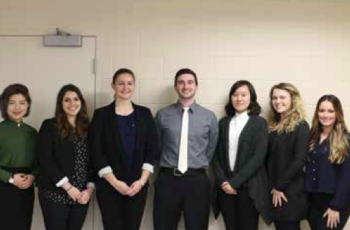
Team Members (L-R): Yuanxin Li, Tasha Bolda, Lori Comer, Brandon Mathews, Yidi Miao, Sylvia Moulthrop, Linda Lleshaj
American Axle & Manufacturing: Part Standardization: Identify Identical Indirect Items within Database
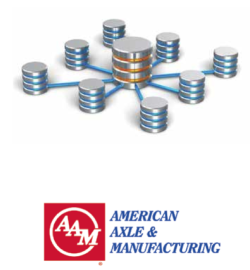 The Michigan State University Team will benefit American Axle & Manufacturing by driving down cost within AAM’s MRO (Maintenance, Repair & Operations). This will be achieved primarily by developing a parts standardization program. They will complete this project in two phases:
The Michigan State University Team will benefit American Axle & Manufacturing by driving down cost within AAM’s MRO (Maintenance, Repair & Operations). This will be achieved primarily by developing a parts standardization program. They will complete this project in two phases:
The first phase is to analyze AAM’s master data and develop a methodology for identifying duplicate items in the database that are made by different OEMs. After, they will report their findings and calculate the inventory reduction opportunity due to the consolidation of common items.
The second phase is to be able to implement this newly created methodology throughout the company. This will eliminate any coding duplicates in AAM’s database. It will also prevent duplicate coding when requests for any new items are submitted.
ArcelorMittal: Scrap Logistics Optimization and Cost Minimization
 The ArcelorMittal Scrap Purchasing Team is responsible for procuring scrap steel for seven of their USA plants. Scrap steel is an input in the manufacturing of steel. Each month, they look at production levels and forecast how much scrap will be required to produce the expected tonnage. They try to use internally generated scrap first, and then any excess needs must be bought on the market.
The ArcelorMittal Scrap Purchasing Team is responsible for procuring scrap steel for seven of their USA plants. Scrap steel is an input in the manufacturing of steel. Each month, they look at production levels and forecast how much scrap will be required to produce the expected tonnage. They try to use internally generated scrap first, and then any excess needs must be bought on the market.
There are several scrap commodities that are priced differently according to their grade. “Prime” scraps are the most expensive, “Cut” or “Obsolete” grades are the least expensive and the “Shred” grade can vary. Each plant has a different mix of commodities that they use for their scrap input. Additionally, some of their facilities only accept certain types of scrap because of the type of steel that they make.
The goal is to create a model in Microsoft Excel that incorporates the various prices of the scrap commodities, the levels of inventory at each site, and the constraints in the scrap mix. The model will be constructed for various site locations. It needs to be noted that the ideal inventory levels should be maintained throughout the month as the sites do not want to run out of scrap but also do not want to keep too much on-site. In addition, the company wants to purchase as much non-prime scrap as possible in order to decrease the purchasing cost.
The final Excel model will have the capability for adjustments in prices and tonnages. This model will be used to track, purchase and plan for scrap across each ArcelorMittal USA Plant.

Team Members (L-R): Evan Swoish, Alex Peterson, Maggie Arnold, Justin Holdsworth, Lauren Muncie, Cheng Song, Zetian Zhou
Asahi Kasei Plastics: Logistic Network and Trailer Optimization
 Asahi Kasei Plastics is a highly competitive manufacturer of high performance plastic compounds for OEMs and suppliers globally. Asahi Kasei’s materials are used to make a wide variety of products ranging from automotive parts to spa and pool components, while still offering the highest degree of customizability for their customers.
Asahi Kasei Plastics is a highly competitive manufacturer of high performance plastic compounds for OEMs and suppliers globally. Asahi Kasei’s materials are used to make a wide variety of products ranging from automotive parts to spa and pool components, while still offering the highest degree of customizability for their customers.
With manufacturing plants and warehouses across the United States, Asahi Kasei Plastics must maintain a highly versatile and efficient supply chain to provide excellent service to their customers located around the world. Over the last 5 years Asahi Kasei plastics has been growing rapidly, and this has caused the logistics team to search for even more efficient solutions and tools to optimize their current supply chain network.
To assist with this challenge, Asahi Kasei Plastics has enlisted our team to analyze current logistics operations, and identify cost-saving opportunities that currently exist within the logistics network as Asahi Kasei Plastics moves towards leaner and more competitive carrier operations. This project includes analyzing the modes of transportation currently utilized by the Asahi Kasei Plastics logistics team, as well as material and packaging costs, and historical shipping data. Truckload (TL) and Less than Truckload (LTL) carrier pricing are also crucial variables considered in the analysis along with customer order frequency, due dates and ship-to locations. Using this analysis, the team is engineering macros within Microsoft Excel that will automate reporting and optimize current routing capabilities. Such automation will help Asahi Kasei Plastics realize cost- saving opportunities in their logistics network.

Team Members (L-R): Aaron Zabik, Shana Li, Matt Wozniak, Pakhuri Bajaj, Mohamed Seddik, Yichun Fan, Hunter Moran
Continental: Review Camera Market Assessment
 Hello from the Continental rearview Market Analysis Team! Throughout the semester, our team has produced a front-to-back market analysis on rearview camera systems which involved 4 major milestones:
Hello from the Continental rearview Market Analysis Team! Throughout the semester, our team has produced a front-to-back market analysis on rearview camera systems which involved 4 major milestones:
- Consumer Feedback: What do customers think about various rearview camera systems?
- Aftermarket opportunities: In terms of vehicles without rearview camera systems, what aftermarket opportunities exist? How big is this market? Where should we price the rearview camera?
- Competitive camera teardown analysis: How is the camera packaged? What key attributes exist with these cameras?
- Vehicle performance benchmarking: Who is providing cameras to customers in North America? What other features could be added?
Continental left the project completely open-ended and said they are looking for a fresh perspective on this market. The project entails utilizing knowledge in various fields in order to come up with the best possible snapshot of the market for rearview cameras. This is especially important now that all cars are mandated to have some form of camera system integrated into the car. The rearview camera is still relatively new to cars. This means we need to have a better understanding of the market, the wants and needs of various consumers to give Continental a better competitive advantage.
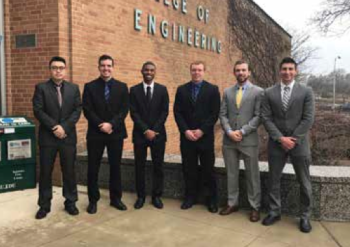
Team Members (L-R): Jingxuan Liang, Matt Mueller, Nathan Gray, Connor Mohr, Paul Wagner, Matthew Bloom
Dow Industrial Solutions: Extending ATP Capabilities through Improved Supply Chain Visibility
The Dow Chemical Company is the second largest chemical manufacturer in the world and is based an hour and a half north of East Lansing in Midland, Michigan. With 2016 sales totaling $48.2 Billion, Dow is responsible for sending chemical-based products all over the globe. Internally, they are divided into 9 key divisions such as Agriculture, Automotive, Consumer and, our division of focus, Industrial Solutions.
 Dow, like many other industry leaders, utilizes an internal enterprise resource planning system called SAP ECC. Every time a finished product moves within their network a data point is created. All of this data allow Dow to see how much of each finished good they have so that when a customer submits a purchase order, they know immediately if they have the inventory to fill the order. This finite amount of inventory is referred to as available to promise inventory (ATP). The current equation in SAP ECC to calculate ATP is the amount of inventory on hand in the warehouse plus the amount of material that the onsite plant is producing. This gives their planning teams a good amount of inventory to work with, but it is missing a key element. That element is Finished Good inventory that is currently in transit and has not arrived at the warehouse yet. Dow, a global company, has in-transit materials from all regions of the globe and via many different modes of transportation.
Dow, like many other industry leaders, utilizes an internal enterprise resource planning system called SAP ECC. Every time a finished product moves within their network a data point is created. All of this data allow Dow to see how much of each finished good they have so that when a customer submits a purchase order, they know immediately if they have the inventory to fill the order. This finite amount of inventory is referred to as available to promise inventory (ATP). The current equation in SAP ECC to calculate ATP is the amount of inventory on hand in the warehouse plus the amount of material that the onsite plant is producing. This gives their planning teams a good amount of inventory to work with, but it is missing a key element. That element is Finished Good inventory that is currently in transit and has not arrived at the warehouse yet. Dow, a global company, has in-transit materials from all regions of the globe and via many different modes of transportation.
Our project will focus on analyzing the different modes of transportation used by Dow and determining the confidence level that will ensure on-time arrival of material in order to add it to the ATP equation. The main modes that we will analyze are truck, rail, marine pack cargo, and deep sea vessels.
We will be analyzing historical delivery data to see which modes yield the most consistent on-time delivery for both domestic and international shipments.
By determining which modes of transportation are most reliable using their confidence level, Dow will be able to utilize those formulas in SAP ECC to add the in-transit shipments to their ATP equation. This will result in a decrease in the amount of inventory Dow needs to hold in their warehouse without decreasing their high level of service.
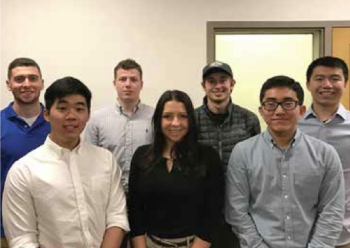
Team Members (L-R): Brad Perri, David Lee, Kevin Quinn, Megan Campbell, Ben Labadie, Sung Lee, James Dong
Great Lakes Wine & Spirits: Warehouse Space Optimization
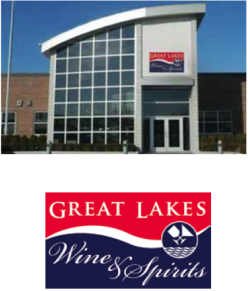 Great Lakes Wine & Spirits represents Michigan’s largest wine and liquor distributor spanning a reach that services all 83 Michigan counties with its headquarters located within Highland Park. Currently, the company serves approximately 10,000 customers while carrying about 6,000 unique wine items as well as over 3,000 various spirits. With an ever-increasing supply chain network, the company works to accommodate all of its customers by supplying its inventory in three distinct ways. Customers can place orders for entire pallet picks and case picks, as well as individual bottle picking, through “split cases” all based on the desired quantities requested. The company also supplies the smallest of community stores all the way to industry retail giants such as Sam’s Club and Costco. With countless orders, dispatch locations, and quantities, the company strives for complete accuracy, as well as swift turnaround times, with orders being placed and filled overnight via deliveries. Currently, the company is facing an issue with space within their Highland Park and Detroit warehouses.
Great Lakes Wine & Spirits represents Michigan’s largest wine and liquor distributor spanning a reach that services all 83 Michigan counties with its headquarters located within Highland Park. Currently, the company serves approximately 10,000 customers while carrying about 6,000 unique wine items as well as over 3,000 various spirits. With an ever-increasing supply chain network, the company works to accommodate all of its customers by supplying its inventory in three distinct ways. Customers can place orders for entire pallet picks and case picks, as well as individual bottle picking, through “split cases” all based on the desired quantities requested. The company also supplies the smallest of community stores all the way to industry retail giants such as Sam’s Club and Costco. With countless orders, dispatch locations, and quantities, the company strives for complete accuracy, as well as swift turnaround times, with orders being placed and filled overnight via deliveries. Currently, the company is facing an issue with space within their Highland Park and Detroit warehouses.
Vast amounts of products and increasing customer demands have led to problems with stocking product in-house to be able to fill the demand of customer orders. In recent years, the holiday bustle of the industry-known October, November, and December (OND) months has led to the biggest spatial issues with the alcohol sales spikes nearing holiday seasons. The goal Future 4 Solution faces is to optimize the current space that GLWAS houses within these two main warehouses given the current constraints. The team will encounter spatial reorganization, optimizing of layouts following safety specifications and codes, as well as monitoring and adjusting capacity to correct this current concern. Finally, measurements will be recorded in the form of inventory quantities as well as time with intake and turnaround to better optimize space and capacity of the GLWAS facilities.
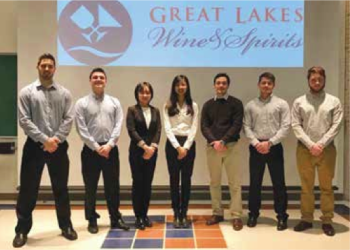
Team Members (L-R): Alex Haik, Derek Friess, Shuning Liu, Yini Luo, Nick Kobak, Travis George, AJ Miles
Hess Corporation: Master Labor Material Group: Development & Implementation
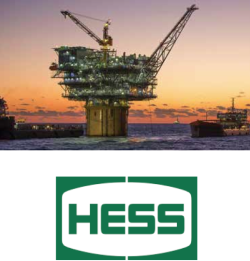 Hess Corporation is a global exploration and production company in the business of developing and producing crude oil, natural gas liquids and natural gas. Headquartered in Houston, Texas, Hess has a global presence in their onshore, offshore and exploration of natural gas and crude oil. The objective of this project is to enhance Hess’ lean processes and procedures.
Hess Corporation is a global exploration and production company in the business of developing and producing crude oil, natural gas liquids and natural gas. Headquartered in Houston, Texas, Hess has a global presence in their onshore, offshore and exploration of natural gas and crude oil. The objective of this project is to enhance Hess’ lean processes and procedures.
At the beginning of the project, Hess had inconsistencies within their SAP system, which resulted in incomplete and inaccurate spend data for their labor categories. In the first month, the team spent time analyzing Hess’ initial state of labor classifications, which allowed the creation of a high-level, standard definition of labor to use consistently throughout the company. The second phase dealt with exploring Hess’ data structure and spend data to understand and identify areas of concern. In the third phase, there was a proposed updated labor material groups from the team suggested labor definitions. The last phase was spent sorting the material groups into sub- categories for improved visibility of non-employee labor spend.
To aid Hess in the long term, the team established guidelines to provide alignment across all functional areas, which will allow them to accurately capture and classify global labor spend data. The completion of this project will provide the foundation for improved visibility of non-employee labor within SAP.

Team Members (L-R): Samuel Hansen, Jessica Totten, Justine Adamo, Michael Baron, Julia White, Mara Murray, Erika Lentz

